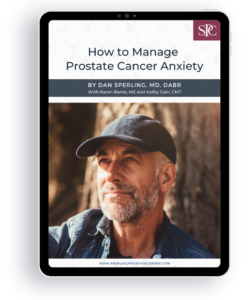It may be true that beauty is in the eye of the beholder, which makes beauty a matter of debate. There is no objective standard for beauty. What an individual sees as beauty is actually a matter of taste or opinion. However, whether or not a suspicious mass of tissue is seen as prostate cancer (PCa) should not be a matter of opinion or debate. And yet, that’s exactly the case with Gleason 3+3=6 (Grade Group 1 or GG1) prostate cancer.
According to a Jan. 2021 article in MedPage Today, “Some urologists see a Gleason 6 as a noncancerous growth that has the potential to be invasive, but most likely will never spread to other organs or end up killing a man.”[i] Put another way, some see Gleason 6 as malignant, some don’t. Currently, it’s still under debate.
Keep in mind that diagnosing PCa is truly a matter of what a pathologist beholds under a microscope. How the cells appear to the eye gets assigned a number, or Gleason grade, ranging from 2-5. (The number 1 is never used, since it means completely normal.) Since a grade of 2 is so close to normal, it is excluded from reporting. Therefore, a Gleason score, or sum of the two largest percentages of abnormal cells per biopsy needle, is reported with a plus sign, starting with the lowest score of 3+3=6. In the new Grade Group system, this becomes the lowest Grade Group out of 5. In other words, Gleason 3+3 is lumped into GG1.
Is it prostate cancer or isn’t it?
This brings us to two questions. Should GG1 be seen as PCa, and labeled as such?
One of the top experts in PCa grading is Dr. Jonathan Epstein, Professor of Pathology, Oncology and Urology at the Johns Hopkins School of Medicine, weighs in on the controversy over whether Gleason 3+3 (GG1) should be presented as true cancer to patients. In a Jan. 2022 journal essay, he lays out the pros and cons:
| Let’s see it as cancerous | Let’s see it as noncancerous |
| In the eye of the beholder, GG1 often has the same appearance of GG2 or higher so it might be more dangerous than it looks | The term “cancer” is scary and will lead to over treatment, with its risks of side effects, when Active Surveillance (AS) would be a safe alternative |
| It can show as perineural invasion or extraprostatic extension so it might behave invasively, as cancer does | Gleason 3+3 is indolent, meaning it tends to stay the same or change very slowly so it doesn’t behave like cancer |
| Molecularly, it has many hallmarks of PCa | |
| Calling it noncancer can lead to inconsistencies and confusion in reporting | |
| Biopsy sampling error might have missed higher grade cancer, so don’t take chances | |
| Men on AS may have a false sense of security, believing it’s not really cancer, and therefore not comply with monitoring protocols | |
| If GG1 is treated, the prognosis (likely outcome) may be better than if it’s called noncancer and left untreated | |
| Naming Gleason 3+3 as GG1 PCa helps patients recognize it as the lowest risk but still cancer, thus encouraging compliance with the safety of monitoring if they choose AS |
Based on the above, Dr. Epstein concludes that doctors and patients should continue to behold Gleason 3+3 (GG1) as PCa.[i] If you follow his thinking, now you see it, so keep the word “cancer.”
If Grade Group 1 is cancer, what are the choices?
Dr. Epstein notes that “…patients are increasingly adopting active surveillance, recognizing that not all prostate cancers are the same and GG1 can be followed carefully and safely on active surveillance.” It is true that AS is being recommended as a lifestyle-preserving course of action for patients with GG1. However, many men experience anxiety over the idea of leaving PCa in their body while trusting monitoring to detect a change in time for a potentially curative treatment.
This kind of anxiety can be relieved by undergoing a focal treatment that destroys the low-grade tumor with low-to-zero risk of side effects, depending on the size/location of the tumor. Treatments such as Focal Laser Ablation (FLA), MR-guided Focused Ultrasound (MRgFUS) or MRI-guided Transurethral Ultrasound Ablation of the Prostate (TULSA-PRO) are effective and safe. They remove the threat of the tumor while leaving rest of the prostate amenable to AS.
Patients must be carefully qualified to ensure that they are candidates for a focal therapy. To learn more, contact the Sperling Prostate Center, a leading provider in MRI-guided focal treatment of prostate cancer and BPH.
Download Our Free Ebook: “How to Manage Prostate Cancer Anxiety”

Don’t let anxiety over prostate cancer run you. Instead, learn how you can take charge and empower yourself to manage stress and boost positive treatment outcomes with our “first aid kit” of practical tips and tools.
NOTE: This content is solely for purposes of information and does not substitute for diagnostic or medical advice. Talk to your doctor if you are experiencing pelvic pain, or have any other health concerns or questions of a personal medical nature.
References
[i] Wolinsky, Howard. “Is This Really Cancer?” MedPage Today, Jan. 8, 2021. https://www.medpagetoday.com/special-reports/apatientsjourney/90601
[ii] Epstein JI. Is Grade Group 1 (Gleason score 3?+?3?=?6) adenocarcinoma of the prostate really cancer? Curr Opin Urol. 2022 Jan 1;32(1):91-95.


